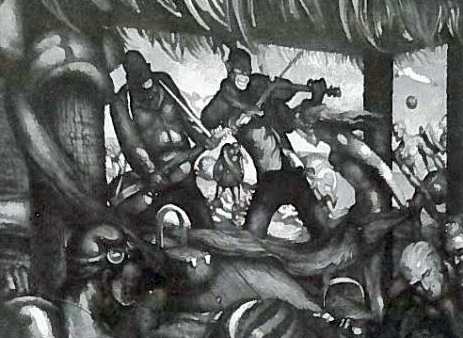Know
Planning commission green-lights historical marker in City Hall mural controversy

The eastern landing wall of St. Petersburg City Hall’s Grand Staircase, blank for 54 years, will soon receive a bronze plaque commemorating the historical incident that left it that way.
Tuesday afternoon, the Community Planning and Preservation Commission voted unanimously to approve the plaque proposed by commissioner Gwendolyn Reese, who is president of the African American Heritage Association of St. Petersburg, Inc., and the city’s Planning and Development Services department.
The 7×10 canvas mural, titled Picknicking at Pass-a-Grille, was created by artist George Snow Hill in 1945 under President Franklin Roosevelt’s Federal Arts Grant. The mural and its companion piece, Fishing on the Pier, depicted “everyday life in St. Petersburg.”

Detail, Picnic at Pass-a-Grille (from a black and white photo)
Picknicking at Pass-a-Grille, however, became a lightning rod for controversy. Hill’s painting of stereotypical “minstrel show” African Americans entertaining whites under a beach pavilion aroused the ire of the city’s Black community. Complaints about the mural’s offensiveness grew louder, and more frequent, as the 1950s turned into the ‘60s.
By December 1966, Joseph Waller had had enough. After numerous unheeded requests to city officials, the vice chairman of the Florida front of the Student Non-Violent Coordinating Committee walked into City Hall, cut the canvas down, and accompanied by several friends marched it loudly up Central Avenue.
At 6th Street, the men were arrested. “We too are opposed to any stereotype painting of any nature,” proclaimed NAACP Field Director Marvin Davies, while condemning the actual act of vandalism. “Some people attempt to justify the appearance of the mural as one of historical accuracy.”
Waller spent two years in prison. In 2000, Florida governor Jeb Bush restored his rights.
As Omali Yeshitela, Waller founded the Uhuru movement in 1972; his African People’s Socialist Party is still based in St. Petersburg.
While the benign Fishing At the Pier remains mounted on the other ride of the staircase to this day, its mate has never been replaced. Waller/Yeshitela’s act is considered a defining moment in St. Petersburg’s civil rights movement.
Following a presentation Tuesday by Derek Kilborn, Manager of the Urban Planning and Historic Preservation Division, the commission agreed on the three things with which they were tasked: That the incident indeed occurred, that the event was historical, and that the wording on the proposed plaque is accurate.
Although public comment was solicited for the widely publicized virtual meeting, there was none. Commissioner Christopher Burke suggested the vote might, therefore, be premature.
“Joseph Waller is a very controversial figure in our city,” Burke said. “Very controversial. And to let this fly through without some discussion on that, I think is a little bit short-sighted. But I’m obviously very alone in that concern.”
Added commissioner Copley Gerdes: “I do have some concerns with not hearing any public feedback. I appreciate that we probably did some really hard work in this arena to make sure we’re doing the right thing.”
The plaque, and its placement, do not have to be approved by another policy-making body, Kilborn told the commissioners.
“Procedurally,” he said, “in terms of the marker and monument policy, this is the one step. There is no City Council requirement after this review today.”
Picknicking at Pass-a-Grille is believed to have been destroyed in the years following Waller’s trial and conviction.
“This plaque commemorates a seminal event in St. Petersburg’s history during the Civil Rights Movement. Until 1966, two murals by painter and muralist George Snow Hill hung in this grand staircase. The murals illustrated scenes of early St. Petersburg. One of which, in this space, depicted a scene viewed by many as being racially offensive. Visitors to City Hall, including African Americans, were subjected to the mural for two decades. In December 1966, after a letter from the Student Nonviolent Coordinating Committee asking for the mural to be removed was ignored, twenty-five-year-old Joseph Waller physically removed the offensive mural from the wall. He was arrested, charged, and convicted of felony theft and spent at least 22 months in prison prior to having his rights restored by the Florida Cabinet in 2000.
This wall shall forever remain blank in recognition of this act and in tribute to the countless contributions our African American residents have made to the City of St. Petersburg.”







